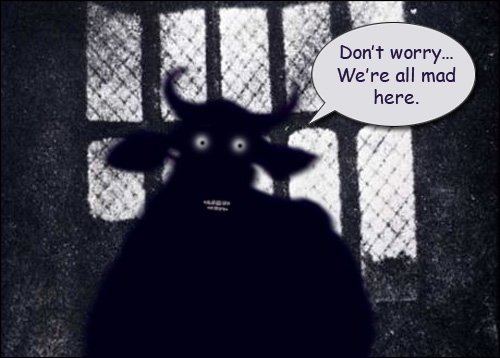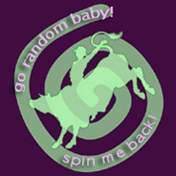Thu 24 Mar 2011
Last Night I Saw Upon the Stair…
Posted by anaglyph under Bizarre, Creepy, Medicine, Science
[26] Comments

Charles Bonnet Syndrome is an unusual neurological affliction that causes mentally healthy people to see things that aren’t actually there. It is usually associated with advancing age and is thought to affect between 10% – 40% of people. Hallucinations seen by those with Bonnet’s Syndrome range from colourful patterns and textures on walls, through out-of-place objects such as bottles and vases of flowers, to animals and faces and people. Perhaps one of the strangest things about the affliction is that the hallucinated items often appear to interact with the sufferer’s real environment. Charles Bonnet, who first described the disorder, observed it in his 89 year old grandfather who hallucinated birds, horse-drawn carriages, animals and perhaps most disturbingly of all, a man who would come into his bedroom and smoke a pipe in the evenings, and who was still there the next morning when the old man awoke…
The British Medical Journal reports the case of an 87 year old widower who had, for six weeks previous to his diagnosis with the condition, been seeing people and animals in his house, including bears and Highland cattle.
He knew that these visions were not real and they didn’t bother him much, but he thought he might be losing his mind. The visions lasted for minutes to hours, and the cattle used to stare at him while quietly munching away at the grass.
Bonnet’s Syndrome occurs mostly in people with some kind of macular degeneration, and the most likely explanation for what is going on is that the sufferer’s brain, lacking the visual information it is accustomed to receiving, feels obliged to conjure up something to fill the space. That it chooses to integrate that ‘something’ with the world of the patient is perhaps the weirdest part of the illness.
The lesson here, in case this post seems somewhat obtuse, is that you quite literally can’t always believe your eyes. The strangeness of Charles Bonnet Syndrome illustrates profoundly how deeply etched into our being is the ‘need’ to make sense of the world in some way when deprived of the proper data. In the case of the sufferer of Bonnet’s Syndrome, the brain makes an unmistakeable and totally misleading judgment call.
If you’d like to read more about Charles Bonnet Syndrome there’s a great piece on Damn Interesting.
___________________________________________________________________________
Image (in part) by William Fox Talbot from Wikimedia Commons
___________________________________________________________________________




I think Joey has this disease.
[img]https://lh3.googleusercontent.com/_57Ka0pJpiyE/TYrXyDhMgrI/AAAAAAAAAw4/I3bG93w37DY/joeybonnet.jpg[/img]
Now if I started seeing something like that, I’d be seriously worried.
Now that is interesting. Meshes perfectly with what Oliver Sacks has to say about auditory hallucinations in Musicophilia – particularly in older people, as their hearing gets worse, their brains fabricate replacement sounds.
Interestingly enough, I did read that people with Charles Bonnet Syndrome rarely have auditory hallucinations. I guess that would require a simultaneous partial loss of both sight and hearing.
I did read that once the macular degeneration progresses past a certain point, the Bonnet Syndrome subsides. The brain probably goes past a point where it has enough information to make the hallucinations seem plausible…
why don’t they see people like Emma Watson or Angelina Jolie? Those are halucinations I live with. Especially if they were still there in the morning!
Those are halucinations I ‘could’ live with. Don’t have them yet but there is always intercessitional prayer. “Dear god give me vision Emma Watson!!”
Oh well what the hell, I’ll propably get Liz Taylor or Boris Karloff.
Call me perverse, but I’d actually really like Boris Karloff.
If you suffered from Charles Bonnet syndrome and Capgras Delusion, your hallucinations would be replaced with exact replicas.
But how could you tell?
Who are you and what have you done with the Reverend?
More to the point, whose cow is that?
One of our patients had it
http://nursemyra.wordpress.com/2008/09/02/pass-me-my-bonnet/
Ha. Even as I was writing it I knew you would have been there before!
… and it’s all thanks to you xx
There was a man upon the stair
When I looked back, he wasn’t there
He wasn’t there again today
I think he’s from the CIA.
That’s been stuck in my head since I was a kid… I just discovered this version was originally in Mad magazine.
Yes, the poem is called ‘Antigonish’ and was written by William Hughes Mearns. In full:
Yesterday upon the stair
I met a man who wasn’t there
He wasn’t there again today
Oh, how I wish he’d go away
When I came home last night at three
The man was waiting there for me
But when I looked around the hall
I couldn’t see him there at all!
Go away, go away, don’t you come back any more!
Go away, go away, and please don’t slam the door
Last night I saw upon the stair
A little man who wasn’t there
He wasn’t there again today
Oh, how I wish he’d go away
It is so redolent of Charles Bonnet Syndrome that one is inclined to think Mearns may have suffered from it (particularly the bit about the ‘little man’. Bonnet Syndrome sufferers frequently report their visitors are tiny versions of real people, and the literature even has a term for it” ‘Lilliput hallucinations’). Mearns was only 24 when he wrote the poem though, so he’s probably just using that thing called ‘imagination’.
:)
Hey! What’s Malach doing in the castle!
Also, I think I see Trotsky (?) on your side bar!
Trotsky was never so dashing.
Isn’t it Charlie Sheen?
Haha. Funny you should say that – Violet Towne said exactly the same thing only minutes ago. And I concur. It does look a little like a dapper Charlie Sheen.
Got a few clients with this, it can be fun
Yea. “Clients” Mmmm hmmm…
Yeah, ‘Physician heal thyself.’
The King
I assume Malach is talking about clients who see him in the room and say “Oh, there’s that weird illusion again – the one that stands and gapes and says nothing intelligible at all, and eventually goes away if I just ignore it”.
Help me, Reverend. I’ve been ignoring him for years, but he won’t go away!